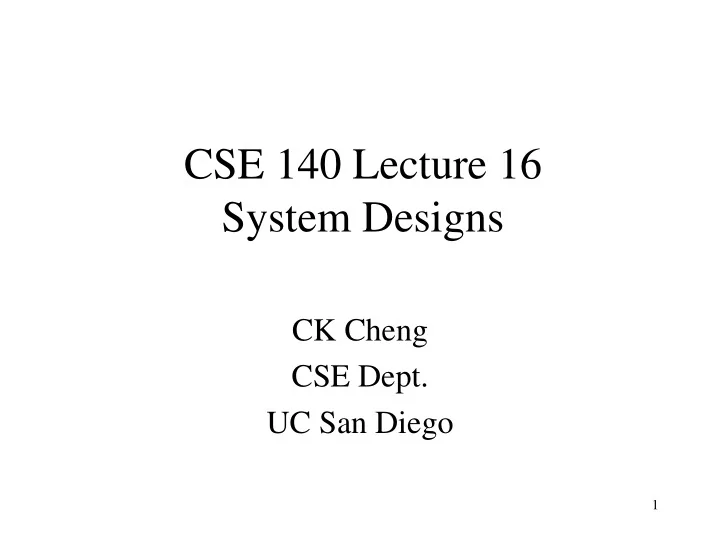

CSE 140 Lecture 16 System Designs CK Cheng CSE Dept. UC San Diego 1
System Designs • Introduction – Methodology and Framework • Components • Specification • Implementation 2
Introduction • Methodology • Approach with success stories. • Hierarchical designs with interface between the modules (BSV). • Data Subsystem and Control Subsystem • For n-bit data, each operation takes n times or more in hardware complexity. • Data subsystem carries out the data operations and transports. • Control system sequences the data subsystem and itself. 3
I. Introduction: Framework n=128 n=64 Data Data Data Subsystem Inputs Outputs Control Conditions Signals Control Control Control Subsystem Outputs Inputs Start/Request Done/Acknowledgement 4
I. Introduction: Handshaking n=128 n=64 Data Data Data Subsystem Inputs Outputs Control Conditions Signals Control Control Control Outputs Inputs Subsystem Done/Acknowled Start/Request gement X Master that Y calls module X Z S Z start module S done Y start done 5
Handshaking start t done t 6
Handshaking 7
Handshaking: iClicker The master module that calls module S controls the following signals A. Signal start B. Signal done C. Signals start and done D. None of the above 8
II. Components Functions Components Data Data storage Storage Modules Subsystem Data operations Operators Data transport Interconnections Control Control of data operations Sequential machines Subsystem Control of data transports Control of the sequential system 9
II. Data Subsystem Components • Storage: Register, RAM, FIFO, LIFO, Counter, Shifter • Operator: ALU, Floating Point Operators • Interconnect: Wire, Buses, Crossbars 10
II. Components: Storage Modules, Register LD: Load D CLR: Clear LD D LD CLK CLR CLR Q Q Q(t+1) = (0, 0, .. , 0) if CLR = 1 = D if LD = 1 and CLR = 0 = Q(t) if LD = 0 and CLR = 0 11
Modulo-n Counter D CNT D TC CNT LD TC LD Clk CLR CLR Q Q Q (t+1) = (0, 0, .. , 0) if CLR = 1 = D if LD = 1 and CLR = 0 = (Q(t)+1)mod n if LD = 0, CNT = 1 and CLR = 0 = Q (t) if LD = 0, CNT = 0 and CLR = 0 TC = 1 if Q (t) = n-1 and CNT = 1 = 0 otherwise 12
Storage Component: Registers, Array of Registers D Registers: If C then R D C LD R Register Array: If C then R address D Sharing connections and controls D LD C Decoder address R 13
Storage Components: RAM, FIFO, LIFO RAM Size of RAM larger Decoder RAM Address than registers Performance is slower FIFO (First in first out) LIFO (Last in first out: Stack) 14
Functional Modules B CASE Op-Sel Is A When F1, Z <= A op1 B Operation When F2, Z <= A op2 B OpA OpB selection . Op-Sel . End CASE Z Example: Z CASE Op-Set Is Z <= (A + B)mod 2 n if Op-Sel=addition, Z <= (A - B)mod 2 n if Op-Sel=subtraction End CASE 15
Interconnect Modules (Wires and Switches) • Single Lines • Band of Wires • Shared Buses • Crossbar 1. Single line (shifting, time sharing) Shift Register Shift Register 16
2. Band of Wires (BUS) 3. Shared Bus switch switch switch switch ….. R0 R1 R2 Rn-1 Switches x x x x DEMUX MUX c c d S S 0 1 2 .. n-1 0 1 2 .. n-1 y y Rn-1 Rn-1 R0 R0 17
4. Crossbar (Multiple buses running horizontally) m simultaneous transfers are possible, but more expensive. 64 Bus 0 R0 Bus n-1 Rn-1 MUX0 MUX1 MUXn-1 … 18
Crossbar Switches: VLSI Design 19
Multistage Network: Clos Network 20
Multistage Networks: Benes and Omega Networks Blocking: Previous assignment can block the next route. 21
III. Specification: Program 1. Objects (Registers, Outputs of combinational logic) 2. Operation (Logic, Add, Multiplication, DSP, and etc.) 3. Assignment 4. Sequencing Example: Signal S1, S2, R[15:0]: FFs, Registers, wires Z A + B: Registers, Adder, Interconnect R1 R2: Registers and Interconnect Begin, End: Control if ( ) then ( ), ENDIF: Control 22
S1 Ex. If C then R1 S1 Else R2 S2 R1 LD Endif; C S2 R2 LD A B C If C1 then X A Adder Else X B + C Endif If C2 then Rg X 1 0 C1 MUX Endif CLK C2 Rg 23
System Designs • Introduction – Methodology and Framework • Components • Specification • Implementation 24
VI. Implementation ▪ Example ▪ Handshaking ▪ Request and Acknowledgement ▪ Datapath Subsystem ▪ Data Operators ▪ Data Transporters ▪ Control Subsystem ▪ One Hot Machine Design 25
VI. Implementation: Example AddModule(X, Y, Z, start, done) { Input X[15:0], Y[15:0] type bit-vector, start type Boolean; Local-Object A[15:0], B[15:0] type bit-vector; Output Z[15:0] type bit-vector, done type Boolean; S0: If start’ goto S0 || done 1; S1: A X || B Y || done 0; S2: Z Add(A, B) || goto S0; } Exercise: Go through the handshaking, data subsystem and control subsystem designs. 26
AddModule(X,Y,start,done) X Y Call AddModule X Z Z start AddModule Y done start done 27
iClicker Suppose that each step (Si) takes one clock cycle. How many clock cycles does the AddModule take to complete one handshaking iteration? A.One cycle B.Two cycles C.More than two cycles 28
Recommend
More recommend